Cover Story
Transforming Healthcare
| USF News
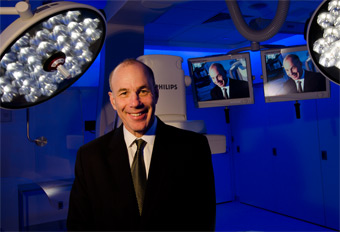
CAMLS takes simulation to a new level says Dr. Stephen Klasko, CEO of USF Health. The facility offers every possible form of education and training for health professionals under one roof.
Photo by Eric Younghans | USF News
The pulse of healthcare transformation echoes in downtown Tampa.
Doctors, nurses, pharmacists and other healthcare professionals from around the world are being tested for cognitive, behavioral and technical competence as individuals and teams. Engineers fine-tune prototypes for a new medical device. Military medics treat simulated trauma patients that graphically mimic a soldier seriously wounded in combat. Health professionals at all levels, amazingly, now interact with one another.
And it's all taking place under one roof.
Welcome to the new USF Health Center for Advanced Medical Learning and Simulation (CAMLS).
The $38-million, 90,000-square-foot facility is on the fast track to becoming a national model for improving medical training and patient safety, and creating aggressive and needed healthcare solutions through cutting-edge technology, innovation and simulation.
The new center, which opened in February, will become a job engine for Tampa Bay and is expected to bring 30,000 visitors to the region each year — people who will need hotels, restaurants, transportation and entertainment. It is projected to have a $5.7 million annual impact on the Tampa economy going forward, with an increase of at least 5 percent yearly.
"CAMLS marks an important new chapter not just for USF Health and the Tampa Bay community, but also for how health education and evaluation are performed across America," says Dr. Stephen Klasko, dean of the USF Health Morsani College of Medicine and CEO of USF Health.
Nothing else like it
Nestled in the shadow of Tampa's high rise office towers, the state-of-the-art facility rubs shoulders with a trolley line that links to historic Ybor City, Tampa's Latin Quarter. Riverwalk is steps away, and so too are museums and a performing arts center featuring Broadway plays that mingle with nearby restaurants and sports bars.
CAMLS integrates three floors of innovative simulation experience with education and research excellence. The interior is split into four strategically integrated core components: a Surgical and Interventional Training Center; an Education Center; a Virtual Patient Care Center; and the Tampa Bay Research and Innovation Center.
Remarkably, even before opening its doors, the facility was accredited by the American College of Surgeons and the Society for Simulation in Healthcare and had earned 16 national accreditations for its continuing education programs.
"This is the only place in the country that will start to assess, 'Is this doctor competent?'" says Klasko, whose excitement about the impact CAMLS will have on the future of healthcare is palpable. "The simple fact is that zero doctors have had their technical skills and teamwork competence objectively assessed since they had their medical training."
But the facility isn't just for doctors. It's for nurses, pharmacists, psychologists, combat medics, paramedics, occupational therapists, biomedical engineers and technology specialists. It's for every healthcare professional in every career and at every experience level.
Deborah Sutherland, chief executive officer and the driving force behind bringing CAMLS from ambitious vision to reality, says no other healthcare training facility in the nation can make that claim.
Learners leave the center with a printed report evaluating their technical and cognitive skills, and comparing their skills before and after the learning event. Every procedure and activity is recorded and played back for analysis. Team learners are assessed for individual competencies as well as how they perform as part of a team.
Hands-on surgical and interventional skills center
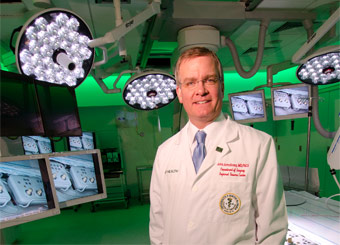
Dr. John Armstrong, CAMLS chief medical officer, says the facility's hybrid catheterization lab is the first of its kind in the world. The multipurpose suite allows healthcare teams to move seamlessly from an interventional procedure to an open surgical procedure saving critical time.
Photo by Eric Younghans | USF Health
In the facility's Surgical and Interventional Training Center (SITC), located on CAMLS' first floor, surgeons, interventional cardiologists, interventional radiologists and residents learn how to perform robotic, computer-assisted and image-guided surgeries. The SITC features the only hybrid catheterization lab in the world — a multipurpose suite that allows healthcare teams to move from an interventional procedure, such as angioplasty, to an open surgical procedure, such as bypass surgery, without leaving the treatment room or switching healthcare teams — changes that typically take about 45 minutes in a scenario where every second counts.
The SITC additionally features one 21-station and two 7-station surgical skills labs. Each station is equipped with everything needed, including a table, instruments, anesthesia hook-up, laparoscopic tools and a light to conduct any type of operation, from jaw surgery to an organ transplant. The labs are supported by an on-site tissue bank and accredited vivarium. There's a trauma operating room, a robotics suite with two high-tech daVinci robots, 11 operating microscopes, a synthetic cadaver and a 64-slice CT scanner, a high-definition scanner that is considered the benchmark technology for CT angiography.
All together, the SITC's 39 surgery stations make it the largest surgical arena in the United States.
In the center's trauma operating room, sights, sounds and temperatures are adjusted to simulate different environments — like battlefields, urban hospital settings, jungles and natural disaster zones.
"We are going to use technology to disrupt the environment in a standardized way," says Dr. John Armstrong, chief medical officer for CAMLS and director for trauma and disaster education at USF Health. "No one has ever done that before."
Teaching individuals to work in teams
Armstrong, a practicing trauma surgeon, joined USF Health last year. He calls the new center "beyond state-of-the-art," adding "there's nothing like it on the planet."
A former colonel in the U.S. Army Medical Corps, Armstrong has focused his career on teaching teams of health professionals how to save lives by working together better. As director of the U.S. Army Trauma Training Center in Miami, a center nationally recognized for its team training expertise, he trained Army forward surgical teams for deployment to the combat zone.
Armstrong says interprofessional team training is a major focus for the center and a vital component for patient safety considering that most medical errors are caused by communication failure between team members.
"We are going to bring strangers together and move them through a simulated environment," he says. "There is tremendous value in that."
Just above the SITC, on the facility's second floor, the interactive Education Center features a 200-person high-tech, tiered auditorium; four classrooms; a high resolution conference room; an executive board room; breakout space; exhibit space; and a built-in registration area. There's even a restaurant-worthy catering kitchen for special events.
A risk-free environment for learning
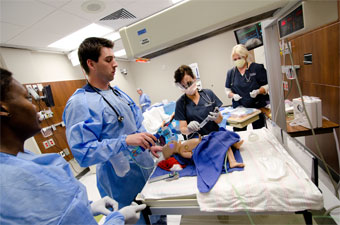
In the Virtual Patient Care Center, individuals and teams hone their clinical and communication skills.
Photo by Eric Younghans | USF Health
At the Virtual Patient Care Center (VPCC) on the facility's third floor, simulation technology allows doctors, nurses, anesthesiologists, therapists and other healthcare providers to hone their skills — from bedside manner to open procedures — in a risk-free environment. The center includes six, fully-equipped patient exam rooms, five team training rooms, three debriefing rooms, eight individual training rooms and a virtual inpatient and retail pharmacy. Surgical simulators allow for individual and team training for endoscopic, laparoscopic and interventional vascular, urologic and gynecologic procedures.
In the debriefing rooms, learners, facilitators and instructors sit together and review recordings of just-completed simulated exercises in a non-threatening, non-judgmental setting. They consider what went right, what went wrong, what could have been done differently, what might have happened. The technology lends itself to recreating past events at another institution, such as a mass casualty scenario or procedure gone wrong, to allow for root cause analysis. It allows healthcare teams to step out of the setting to focus on problems or develop a new process.
"Patients" in the VPCC come in adult, pediatric and neonatal models. There are combat casualty simulators and birthing simulators. The life-like mannequins have a computer-driven, age-appropriate physiology that can mimic routine and crisis medical scenarios. They can convulse, produce breathing sounds, create variations in blood pressure and heart rate, and secrete blood and other imitation bodily fluids. In a crisis they can scream.
"What's going on with my baby? Is he alright? Why won't anyone tell me anything?" shouts an adult-size mannequin with a newborn mannequin nearby, hooked up to a beeping monitor.
"Having visited probably two dozen simulation centers around the world, I'd say CAMLS is one of the state-of-the-art centers that I've seen. I've been very impressed with the organization as well as the physical facilities," says Dr. Sterling Williams, vice president of education for the American Congress of Obstetricians and Gynecologists. "One of the biggest challenges, especially when it comes to procedures, is making sure people are not only competent, but confident. Simulators can provide a vehicle for getting acquainted and polishing up your skills before meeting with the patient."
The future of healthcare training
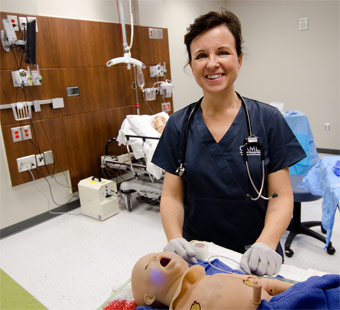
Dr. Laura Haubner, a neonatologist, is medical director of the VPCC.
Photo by Eric Younghans | USF Health
Dr. Darrell Kirch, president and CEO of the Association of American Medical Colleges, says CAMLS is not just a national example, but "an international example of where we're heading around teaching and assessing doctors and other healthcare professionals based on their competence.
"The technology is dazzling, but what's most important to me is the positive impact it will have on patient care — on patient outcomes."
The VPCC is the beta test site for the world's first laparoscopic hysterectomy simulation module, the result of an academic-entrepreneurial partnership between two USF Health faculty members and a team of engineers at the Simbionix Research and Development Center in Israel.
And it is a study in the future of pharmacy education. USF pharmacy students, as early as their first year, work alongside doctors, nurses and treatment teams in the VPCC. They confer on diagnoses, order appropriate medications and corresponding lab work, and demonstrate competency at preparing medication orders safely. Orders are transmitted wirelessly to the hospital's virtual inpatient and retail pharmacies where they're filled by other USF pharmacy students and sent back to the patient's room.
"The concept of having a skills lab is not new, but the ability to do it in a professional environment that comes as close to the real thing as possible is clearly a competitive advantage," says Kevin Sneed, PharmD, dean of the USF College of Pharmacy. "With CAMLS we are capable of creating the most highly trained individuals you will find in any pharmacy setting. We will be able to implement brand new ideas to transform the pharmacy environment and acclimate students to be part of a brave new world."
Developing better devices

Dr. Stuart Hart, a urogynecologist, leads the facility's Tampa Bay Research and Innovation Center, a hub for collaboration and innovation.
Photo by Eric Younghans | USF Health
Just steps from the VPCC, at the Tampa Bay Research and Innovation Center (TBRIC) on CAMLS' third floor, scientists, engineers, doctors and industry partners work together to develop new, better and safer devices, procedures and instruments for patient care. The largely open space is designed to encourage collaboration. Walls in the team room are whiteboard from ceiling to floor; natural light pours in through the windows.
TBRIC's modeling and simulation room allows researchers to generate advanced anatomical and analytical models. A rapid prototyper — a three-dimensional printer — produces silicone models, such as pediatric teeth and gums, complete with muscles and bones. Each model is produced to scale and has rigid and flexible parts. Visiting healthcare professionals use the models to test new devices, like soft tissue lasers and dental cleaning instruments.
The real-life innovation zone puts everything under one roof — from research to market. That means new and innovative medical technologies and products get to market faster — technologies and products tested by doctors and other healthcare professionals to identify potential hazards and ensure safe and easy interface between users and patients.
A real-life laboratory for improved patient care
Sutherland calls CAMLS "a real life lab for training students and healthcare professionals using the latest in technology to assure better patient outcomes."
She says about a third of users will come from USF. The rest will come to Tampa from across the state, across the nation and across the globe. All will be assessed and evaluated based on the specific performance criteria culled from statistical analysis and developed in concert with key medical societies and professional organizations.
Those learners, Sutherland believes, will be pleased with the strategic location of CAMLS in downtown Tampa.
The trolley line provides a scenic ride past the Port of Tampa to Ybor City, a National Historic Landmark District featuring restaurants and nightclubs in red brick buildings with wrought iron balconies. It's a short walk to luxury hotels and Tampa's burgeoning Riverwalk. The Tampa Bay Times Forum, home to the NHL's Tampa Bay Lightning, is in sight, along with cruise ship berths, the Channelside entertainment complex and the Florida Aquarium, where visitors can dive with sharks or take a Dolphin cruise.
"We're doing all this in an urban environment that allows USF to take a leadership role in the City of Tampa and the redevelopment of downtown Tampa."
Early success
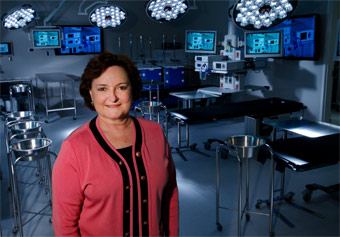
CAMLS CEO Deborah Sutherland says innovative partnerships with specialty societies, industry partners, the defense health system and other health-related organizations have helped steer the facility's early success.
Photo by Eric Younghans
Weeks before opening, the academic-entrepreneurial center had nearly 700 outside bookings — courses and events scheduled by learners and stakeholders across all healthcare specialties. But it wasn't just bookings that kept the center's phones ringing, it was genuine interest in an idea whose time has come.
"Our success is partly due to the strategic partnerships that we have formed with specialty societies like the American Congress of Obstetricians and Gynecologists; the American College of Surgeons; the American College of Cardiology; third party payors; industry partners like Stryker, Philips, Covidien and Mckesson; the defense health system; and other health-related organizations," says Sutherland. "We share a mutual vision for transforming healthcare through transforming education and innovation."
CAMLS is a concept that can be replicated in other parts of the nation and other parts of the world. Already there is interest from other countries about the posibility of building the next CAMLS.
And it is those possibilities that Klasko, Sutherland and others feel will further advance USF's leadership role in transforming the future of healthcare.
It has been called an economic engine for Tampa Bay, the only center of its kind worldwide, a center for innovation. Here's what Tampa Bay leaders are saying about USF Health's Center for Advanced Medical Learning and Simulation.
"This particular project will be the single largest economic impact in the downtown central business district for Tampa in the last 10 years. Unquestionably, the impact it will have with the visiting doctors and professionals will be a real game-changer for the City of Tampa."
Mark House
Managing Director, The Beck Group
Immediate Past Chair, Tampa Hillsborough Economic Development Corp.
"The opening of USF Health's CAMLS is the most innovative and unique economic development project to occur in downtown Tampa in decades. The anticipated thousands of visiting medical and scientific professionals, as well as the relocation of related technology and scientific companies, will provide many opportunities for additional hotel rooms, office space, restaurants and other retail. We look forward to welcoming these new visitors and workers in Tampa!"
Christine M. Burdick
President, Tampa Downtown Partnership
"USF is in the lead in transforming the Tampa Bay area into the premier health innovation center in the United States. CAMLS is a concrete example of how our community is moving forward and creating the valuable high-wage jobs that we need. CAMLS not only means construction jobs now, but this is going to build the jobs for the future in Tampa Bay."
U.S. Rep. Kathy Castor of Tampa
"CAMLS is a game-changer for downtown Tampa. Nothing in the last 10 years is as significant or as far-reaching as this project will be."
Tampa Mayor Bob Buckhorn
"Wow, what an achievement for the Tampa Bay community, let alone the meetings industry! Kudos to this world-class facility and to the University of South Florida for making such a valued commitment to the Tampa Bay area."
Kelly Miller
President & CEO, Tampa Bay & Company
"CAMLS is a one-of-a-kind facility providing the world with a gateway into the exploding medical technology capabilities of the University of South Florida and its partners and the opportunities for high-tech expansion in Florida. CAMLS will be the example of positive economic impact for decades to come."
Rhea F. Law
CEO & Chair of the Board, Fowler White Boggs P.A.
Past Chair, Tampa Hillsborough Economic Development Corp.
"CAMLS is a welcome addition to the life sciences economy in the Tampa Bay area. It offers the promise of becoming an extraordinary resource for Florida's medical device industry, further enhancing the growth of an already strong and nationally recognized industry cluster."
Geary A. Havran,
President NDH Medical, Inc.
Chairman, Florida Medical Manufacturers' Consortium, Inc.
"The CAMLS project represents two important things for Tampa Bay — quality jobs, and what we can accomplish when we work together. This facility is also a great representation of an important industry cluster — applied medicine & human performance — identified as a high-impact growth sector which will be the source of much of the job growth in the future for Tampa Bay. The CAMLS project is a shining asset that will only enhance the growth of this sector."
Stuart Rogel
President & CEO, Tampa Bay Partnership
"CAMLS is the most significant project in downtown Tampa since the opening of the Marriott Waterside Hotel & Marina. This state-of-the-art facility will bring medical professionals from all over the world to our destination, and could be the catalyst to continue transforming our downtown into a world-class convention and meetings destination. The hospitality industry is pleased and excited to have CAMLS as part of the community."
Paul Catoe
CEO Emeritus, Tampa Bay & Company